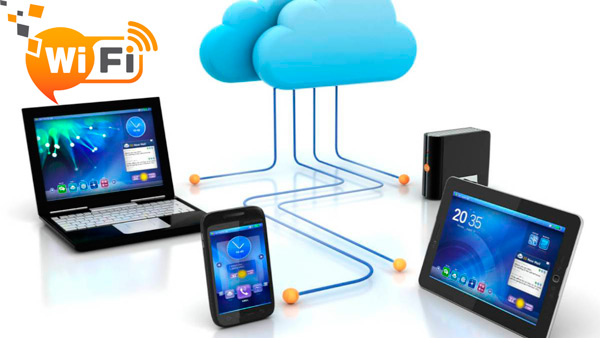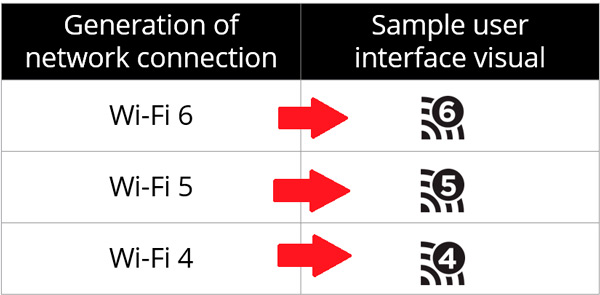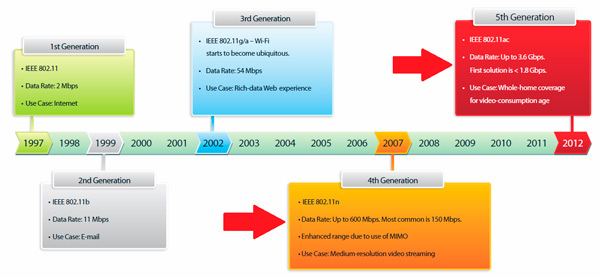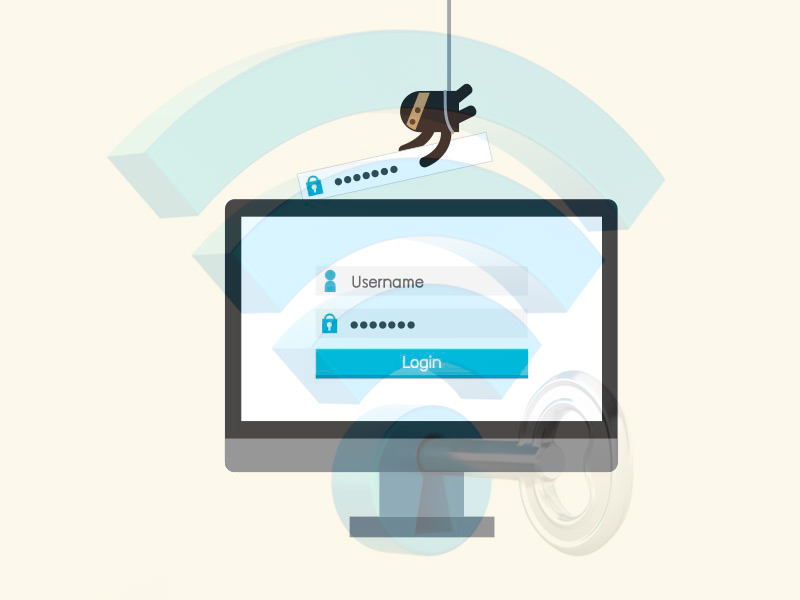
Index:
UPDATED ✅ Do you want to know what a WiFi network is and how it works to provide wireless internet? ⭐ ENTER HERE ⭐ and know everything about it ✅ EASY and FAST ✅
Currently Wi-Fi networks have become one of the most popular tools in the world, and it is that anyone who has used Internet You’ve probably used one of these networks, so you don’t need much of an introduction.
They are usually included in all current smartphonesas well as in any other state-of-the-art technological device. In addition to the routers offered by the different telecommunications companies that have this type of connections.
Therefore, Wi-Fi networks have managed to establish themselves in a very strong way throughout the world, becoming one of the the most important and advanced tools today. Taking this into account, here we explain a little more about them.
100% cable-free Internet What is WiFi and who invented it?

Without a doubt, this type of connection is here to stay, and it is that it has currently managed to replace a large percentage of Ethernet connections, thus eliminating any kind of wired connectionoffering you a series of advantages to each of its users compared to traditional systems cable and ethernet adapters.
And it is that these networks give their users the possibility of being able connect to them through a wireless point with a certain transmission range. You will not need to use the no cables or adapters to establish such a connection. All this has made it a faster and cheaper tool than traditional systems. To do this, here we explain a little more about the history and evolution of Wi-Fi networks.
Source
The first wireless transmissions were in the year 1888, made by the German physicist Rudolf Hertzwho decided to perform an experiment with a oscillator and resonator thus obtaining a favorable result. After this these were continued types of transmissions and in that same year they began to be used as means of communication in radio waves.
For the year 1907 they began to transmit what they were the first complete messages to cross the mid-atlantic. while, in 1971in the University of Hawaii began to design what was the first communication networks packet communication system for radio. These became the first WLAN networkswhich were formed by 7 computers located on different islands where all communicated to a single central computer.
All these projects became the beginnings of these types of connections, until in 1990 technological manufacturers began to include them in their different devices, where companies like Nokia or Symbol Technologies they started to create WECA networks (Wireless Ethernet Compatibility), what happened to be called Wi-Fi Alliance for the year 2003. From this moment on, this technology would begin to be applied in mass use within the devices.
Evolution
When all this technology began to establish it became a complete mess, and it was like that until the year 1997 when it was established IEEE 802.11 standardization or also known as the standardization of the communication of wireless WLAN networks.
Since then, all this has had a constant evolution until today and which we explain below:
- 802.11G standard: This standardization was in force until the year 2003, which served to unite all technologies that have been created so far. They served to upgrade routersthus achieving that they had much more strength in your signalas well as a greater range.
- 802.11n standard: It appears in the year 2009which began to offer higher speed connections thus increasing its effectiveness where data was attributed MIMO (Multiple Input Multiple Output). That is, they used different antennas that they were capable of improve communications signal.
- WIFI overcrowding: Thanks to the appearance of 802.11n standardit was possible to carry out the extension of the range to 4GHz, thus allowing these networks to be at the reach a larger number of devices. However, at the time this caused great inconveniences, since there is a large number of devices connected to the same network caused a congestion in data transmission.
In order to solve these inconveniences, the companies of wireless networks they were forced to build dual band routerswhere links from 2.4GHz and 5GHz simultaneously.
- The Wi-Fi currently: Its use is currently defined in “Rethink Wireless”, where it can be said that this service has continued to improve remarkably, becoming one of the the most important technologies from around the world. So much so, that currently there are points of Free and paid WiFi networks both in homes and public placesbeing available to everyone.
This technology allows all Technological devices, such as smartphones, tablets, desktop computers, laptops, printers, radiosamong many others, can connect to it and carry out a large number of functions in a very simple and fast way.
Wireless Standards
The most commercially used frequencies for connection to Wireless networks are:
- 802.11a: approved in 1999, it brings together the original set of protocols of the standard, operating with a 5Ghz band. The maximum speed is 54Mbit/s, although speeds are usually around 20Mbit/s in practice.
- 802.11b: in this case, also ratified in 1999. With a 2.4Ghz band, a fairly widespread and widely used frequency band. The maximum transmission speed of 11Mbit/s, although in practice it is about 5.9Mbit/s.
- 802.11g: it is an evolution of the previous one, using the same frequency band but with a theoretical maximum speed of 54Mbit/s as in the case of 802.11a. As often happens, the average in practice or real speed usually drops to 22Mbit/s. In addition, there is a variant called 802.11g + that can reach up to 108Mbit / s.
- 802.11n: appeared in 2004 as a new revision of the standard. The real speed in this case reaches up to 600 Mbit/s, which is why it represents a significant jump in performance compared to the previous ones. In addition, it can work in both 2.4Ghz and 5Ghz, so it is compatible with all devices of previous editions.
- 802.11ac: It is the standard that we usually find in the most modern electronic devices and the one that operates with the 5Ghz band. This standard supports speeds of up to 3.46Gbps which allows transfer speeds much higher than Wi-Fi N.
What are the fundamental elements of a WiFi connection?
This type of connections is a mechanism that allows the different Technological devices What smart TVs, game consoles, mobile devices, computersamong others, can connect to a Internet network wirelessly.
These access points They usually have a varied scope that will depend on each of the teams. Furthermore, this type of networks has fundamental elements which we show you below:
Access point
A access point it’s a wifi device which acts as a central point and that allows to interconnect Ethernet networks with wireless networks. Namelywired and wireless networks.
wireless bridge
This has been designed to be able connect two or more networks that are in different locations. In addition, it offers data at a high speed that helps improve connections. These Bridges their main function is to connect those places where it is very difficult to carry a wired connectionnamely, university facilities, non-continuous building floors, widely spaced officesamong others.
Router
This device allows to carry out the interconnection of networks other than wired routers. Many of these devices have the functionality of gateway, they also own WAN and LAN ports, where WAN is considered as a host more of the wired network while LAN is a private network or also known as the private wireless network.
Gateway
The Gateway is the one I know connect to the network and have been designed to allow the hosts of these networks can Internet access. It has security based on Firewall and a NAT/PAT serviceas well as with a server DHCP.
adapters
These are presented according to the connection and there are three types of them, either for a USB, PCI and PCMCIA connectionThey also have antennas that can be external or integrated to them.
PrintServer
In this case its function is the same as for that of a wired network. This will allow you connect a printer or any other device to a network without the need to have a wired Connection, thus improving its operation and the use of the resources of each of the teams.
How does the WiFi router work to provide Internet without cables?

The Wi-Fi router have become a routing team that allows the connection between two or more devices simultaneouslywhich can also be called mediator between devices. Through this device the user will be able to connect to a server from his computer, smartphone or any other technological device.
In the same way, this device must follow a series of processes to be able to wear this Internet signal.
As we explain below:
Establish connection and authentication
This first point is when the devices must establish a connection with the Web, at that moment they all go into detail the corresponding parameters for user identification. This is done from authentication protocols, In addition, this protocol allows the creation of a router access keythus offering greater security.
network reception
Once upon a time router has communicated with the modemwhich is the apparatus in charge of receive cable internet signalit starts working routing hardwarethis is where it starts generate the distribution of the sign.
Signal encoding protocol
All of this is done through the point-to-point protocol (PPP), where I know all information is encrypted, compressed and authenticated. This allows the data that is required to be ready to be delivered to the network nodes.
Route selection
Once you have all the conditions to be able to distribute the data, the next thing will be to find what it is the best route for it. In this case it is necessary that there is efficiency between the sender and receiver.
Data delivery
Once you have chosen the best routethe following will be data package deliverythis is done through radio waves to computer or any other device that has made the request to the Internet server.
reverse path
When any device needs to establish a Internet connectionthis is over communicating with the router, who receives all the information and sends it to carry out a mid workr between the page server and the computer
What is the frequency of a wireless network and what currently exist?

This type of WiFi networks works on two standard frequencies. It is the same one that is in charge of representing the speed with which the network worksthat is, the speed with which data is transmitted and received between devices connected to the Internet. That frequency where they connect technological gadgets It is based on the model of the Network Box and the physical location of the equipment.
In addition, we find different types of frequencies which we explain below:
4th generation
This centralization known as 4G or fourth generation WiFi allows to reduce the number of access points and at the same time improve connection coverage. In addition, it helps reduce signal noiseas well as all microcell spectra that have been used in previous generations, where the frequencies cross causing a more restricted and reduced coverage at the same time.
And it is that this Fourth generation he is able to multiply the bandwidth of third-generation networks by six and the number of users at access points by five, all this helps reduce infrastructure costs. Also, this was all developed by Meru Networks.
5th generation
The fifth generation of Wi-Fi or also known as gigabitWireless and what is called 802.11achas been developed for keep improving the user connections and it is that he works exclusively in the 5Ghz band. where does it have 3.47 speeds Gbps in case of work in ideal conditions.

6th generation
We finally found what it is the 6th generation in WiFi networksthis new 802.11ax standard is found in the development phase and it has been a change that presents a great number of news and features that will allow a large number of devices to access the same network simultaneously where it will not be seen affected in its power and charging speed.
This is how both the products and the networks are able to function under this new 802.11ax standardwhere they currently work with the old standard of the 5th generation. Furthermore, this new WiFi 6 is compatible with all the above protocolswhich will not become a problem for the connection of current equipment.
How to have a secure Wi-Fi password and prevent our Internet connection from being hacked?

Safety is one of the most important factors todayespecially if it is a Internet connection, where we can prevent third parties from hack it and steal data and private and important information. For this it is important to create a good passwordthis being the first step to create a safe environment in the face of any type of danger.
Therefore, here we are going to give you some advices so that you take them into account when creating an access key.
Create a fairly long password
The main characteristic of a secure and strong password is that this is quite long, for this it is recommended that it has as minimum 8 charactersthe more characters it has, the more difficult it will be to discover.
Make a mix of characters
Keep in mind that it is useless create a long security key but let it be an easy or well-known word. In this case it is recommended to use random words and at the same time mix different characters like numbers, letters, symbols, include uppercase and lowercase letters in the whole word.
spell the words incorrectly
A good option for this is to start write the misspelled wordsthis will make your word become a unique phrase difficult to guess for cybercriminals and password crackers. An example of this would be: independent or havrazo, These types of phrases are almost impossible to guess.
What kind of passwords should you avoid?
It is important that you do not put passwords that are very common or easy to guess, like your own names or surnamesor the names of your relatives, it is also not recommended to use passwords such as abc1234, 12345678, password. 11111111, admin or abcdefg.
How many people are connected via Wi-Fi signal in the world?

wireless network connections they have an advantage and that is that they allow you to know which people are connected to them, this will allow you to have a register your signal and according to her to know how it can be the behavior of your network. Currently this Wi-Fi connection type is used throughout the world, becoming one of the most important technologies.
It is used by the world’s big and small companiesas well as by freelancers. Where its importance has been so great that in most countries there are usually squares or public places where do you offer these completely free services to its usersallowing them to be connected to these Wi-Fi networks.
Therefore, it is estimated that at least every 3 people out of 5 in the world they find each other connected to one of these networksbecoming one of the most used and important today.
Internet